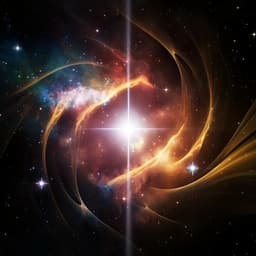
Physics
Towards metropolitan free-space quantum networks
A. Kržič, S. Sharma, et al.
Discover how Andrej Kržič, Sakshi Sharma, and their team have developed a groundbreaking entanglement-based free-space quantum network, achieving secure key rates of up to 5.7 kbps even in challenging conditions like direct sunlight. This research positions free-space systems as a viable alternative for metropolitan quantum communication.
~3 min • Beginner • English
Introduction
The paper addresses how to distribute quantum information efficiently over metropolitan scales when fibre infrastructure is unavailable or impractical. It highlights that current quantum networks, led by QKD, often rely on fibre links and trusted nodes for large distances, which undermines end-to-end security. Over metropolitan distances, the challenges shift to scalability (more users), deployability, flexibility, and interconnecting heterogeneous platforms. Free-space terrestrial links are proposed as an alternative, but face hurdles such as alignment, turbulence, and daylight noise. The authors argue that entanglement distribution is especially suitable for metropolitan networks, enabling untrusted relays and nonlocal correlations, but prior entanglement-based free-space demonstrations were mostly at night and achieved only hundreds of bps over kilometer scales, with daylight demonstrations limited to shorter ranges. The study’s purpose is to make a compelling case for an entanglement-based free-space metropolitan network by developing a deployable system, demonstrating high secure key rates in realistic scenarios (including daylight), and projecting performance for longer links and multi-user configurations.
Literature Review
The authors review prior advances in quantum networks, noting that QKD has driven progress. Long-distance extensions use satellites or fibre-based repeaters. For metropolitan networks, research focuses on scalability, deployability, and interoperability, predominantly in fibre. Free-space entanglement-based QKD has been demonstrated by several groups, with most experiments targeting satellite readiness rather than deployable terrestrial use. Night-time terrestrial free-space entanglement-based QKD over kilometre distances achieved on the order of hundreds of bps, while daylight entanglement-based operation achieved similar rates over ~350 m. Consequently, entanglement-based approaches were considered less mature than prepare-and-measure schemes, particularly for daylight and urban environments. The paper positions its work against this backdrop by aiming for kbps rates over kilometre distances, including in daylight, with a deployable system.
Methodology
System architecture and deployment: The proposed metropolitan network uses a central entanglement server (ES) streaming entangled photons to end users over free-space links. Physical-layer topology is star-like, but entanglement correlations and multiplexing enable a fully connected quantum mesh. The ES can act as an untrusted relay, and the architecture can extend to multiple ESs via a trusted central node or, in the future, via entanglement swapping to maintain untrusted operation. The ES may also interface free-space and fibre segments.
Entanglement server (source): The ES generates polarization-entangled photon pairs via SPDC in a ppKTP crystal within a phase-stable Sagnac interferometer. Pump at 405 nm yields near-degenerate 810 nm pairs (type-II quasi-phase matching at ~30 °C). Pair state coefficients are tuned for a maximally entangled Bell state. Intrinsic pair generation rate ~12 M pairs/s over 0.45 nm FWHM bandwidth. Measured visibilities up to 99.5% (H/V) and 97.4% (D/A) at low pump power. The source is mounted on a breadboard in a 19-inch rack; environment not temperature-stabilized.
Free-space link and terminals: One photon is delivered to Alice via single-mode fibre; the other to Bob via a free-space link with custom transmitter (Tx) and receiver (Rx) terminals. A 1064 nm beacon laser co-propagates with the 810 nm quantum signal, combined/separated with dichroic mirrors. At Bob, a module with four position-sensitive detectors provides feedback to two fast steering mirrors for closed-loop beam stabilization, enabling long-term operation and tight spatial filtering. Telescopes are afocal three-mirror anastigmats with an extra fold mirror; 200 mm aperture; ~73% efficiency at 810 nm; diffraction-limited design over 3.5 mrad FOV; measured wavefront RMS errors ~100–150 nm at 632.8 nm over full aperture (<20 nm over 40 mm subaperture). Large apertures reduce diffraction/turbulence loss. Estimated long-term beam spreading loss (diffraction + turbulence) is ~0 dB for 1.7 km at Cn^2 = 1e-15 m^-2/3 and ~2.1 dB for 10 km at same turbulence.
Quantum receiver subsystems (QRS): Both Alice and Bob use QRS implementing BBM92. Each has a polarization analysis module (PAM) with 50:50 basis choice, 4 SPADs (>60% efficiency, <500 cps dark counts, ~350 ps timing jitter), time-tagging, rubidium clock, and post-processing. Bob’s QRS includes motorized polarization controller, and integrated spectral/spatial filtering for daylight; Alice’s PAM is simplified as it receives via fibre and is not exposed to free-space noise.
Daylight noise filtering: Three-dimensional filtering is used at Bob: spectral (stacked interference filters giving 3 nm FWHM at 810 nm), spatial (Keplerian telescope with adjustable aperture at focal plane reducing system FOV; set to 31 μrad for daylight, ~52 μrad at night; noise ∝ FOV^2), and temporal (coincidence window of 1 ns exploiting tight entanglement timing). Single-mode coupling was not used due to turbulence-induced coupling loss without high-order adaptive optics. The filters are designed to be adjustable for round-the-clock operation.
Experimental scenarios: Primary field test in Jena, Germany over a 1.7 km urban link (Fraunhofer IOF to a distant rooftop container). Two main measurement sessions: night (2 March 2022) with negligible background; day (25 February 2022) with direct sunlight around noon and variable cloud cover. A separate deployment in Bonn connected two government offices over 300 m, achieving similar day/night key rates.
Post-processing and SKR calculation: Time synchronization uses progressive cross-correlation for coarse offset, followed by fine synchronization. Sifting retains same-basis events; 10% of sifted bits are disclosed for QBER estimation. Error correction uses Cascade; correctness is confirmed via universal hashing with 96-bit tags. Secure key length is computed offline including finite-size effects using a composable security proof (Tomamichel & Leverrier). Parameters: 5-minute blocks; δ = 0.034; α = 96; overall QKD failure probability over an authentic channel ε_qkd ≈ 1e-11; ε_pa = ε_qkd × 1e-3; ε_pe = ε_qkd − ε_pa − ε_corr. Overall security parameter ε accounts for authentication and grows approximately linearly with number of blocks n.
System efficiency modeling: Coincidence-window-dependent detection efficiency modeled via error function of the coincidence window and timing correlation width (measured g^(2) FWHM τ0 ≈ 710 ps; 1 ns window yields ~83.8% coincidence acceptance). True coincidences are derived by subtracting accidentals; signal singles obtained by subtracting dark counts and background. Heralding efficiencies η for Alice/Bob are computed from true coincidences and signal singles. Measured dark counts: ~1702 cps (Alice avg) and ~761 cps (Bob avg). Night: η_Alice ≈ 8.90% ± 0.03; η_Bob ≈ 1.63% ± 0.08. Day (Alice channel fibre-based): η_Alice ≈ 8.13% ± 0.09 (characterized the night before); effective day singles for Alice show η ≈ 1.25% ± 0.35 due to filtering state; Bob’s daytime background high, so η_Bob estimated from night values. Independent characterization showed total classical free-space link transmission ~30–35% at 810 nm, including all optics and ~80% multimode coupling.
Background and solar data: Sky brightness estimated from a nearby pyranometer (300 nm–2.8 μm) 1.2–2.6 km away; used as a proxy for daylight noise and correlates with measured background rates at Bob.
Performance projection: For a 10 km link, assume negligible absorption/scattering loss beyond beam spreading; scale SKR linearly with additional transmission factor n ≈ 10^(−2.1/10) ≈ 0.62 derived from beam spreading loss. Multi-link scenarios analyzed by extrapolating measured singles, accidentals, and polarization error rates to two symmetric 1.7 km links (ES in middle) and to wavelength-division multiplexed multi-user networks, assuming uniform spectral partitioning and pump power scaling.
Key Findings
- Achieved secure key rates up to 5.7 kbps over a 1.7 km urban free-space link at night with QBER < 2% and stable performance over several hours.
- In full daylight with direct noon sunlight, maintained QBER ≤ 3.4% and SKR ≥ 2.5 kbps despite background rates >400 kcps (up to 3.8× the signal), enabled by strong spectral, spatial, and temporal filtering.
- Daytime performance tracked solar radiation; transient cloud cover reduced background and improved rates. A later performance drop was traced to ES output reduction rather than sunlight.
- Extrapolation suggests nighttime SKR ~3.3 kbps feasible over 10 km with the presented terminals (estimated additional beam spreading loss ~2.1 dB at Cn^2 = 1e-15 m^-2/3).
- For two independent 1.7 km links (ES centered), extrapolated nighttime SKR > 1.1 kbps is achievable. Under direct sunlight for both links, optimizing filtering (e.g., narrowing spectral filter to 1 nm and optimizing coincidence window) could yield >200 bps, with further improvements possible.
- A separate 300 m government-office link in Bonn demonstrated similar key rates in night and full daylight, showing ad hoc deployability.
- Reported secure keys are ε-secure with ε < 1e-10; ε < 1e-20 is attainable with ~0.1 kbps SKR reduction.
- Measured heralding efficiencies: night η_A ≈ 8.90%, η_B ≈ 1.63%; day characterization η_A ≈ 8.13% (Bob’s η from night used); classical link throughput ~30–35% at 810 nm with ~80% multimode coupling.
Discussion
The results demonstrate that entanglement-based free-space links can deliver kbps secure key rates over kilometer-scale urban paths both at night and under direct sunlight, addressing a key barrier to practical metropolitan quantum networks where fibre is unavailable or impractical. The architecture leverages an untrusted entanglement server to decouple physical line-of-sight between users and to standardize the central node while keeping user-side flexibility. High rates in daylight are enabled by tailored spectral, spatial, and temporal filtering and active beam stabilization. The findings refute perceptions that entanglement-based free-space QKD lacks maturity, showing competitiveness with prepare-and-measure approaches and enabling 24/7 operation potential. Projections indicate that with current large-aperture terminals, city-wide coverage (∼10 km links) with kbps rates is within reach, and multi-user scalability can be achieved via wavelength division multiplexing. The work also lays groundwork for integration with fibre networks (e.g., via non-degenerate 810/1550 nm sources) and for future untrusted extensions via entanglement swapping. Broader implications include enabling other entanglement-based applications such as distributed sensing, clock synchronization, and quantum conference key agreement.
Conclusion
This work proposes and experimentally validates a deployable entanglement-based free-space quantum network architecture for metropolitan applications. A portable ES and robust free-space terminals, combined with passive quantum receivers and comprehensive daylight filtering, achieved record entanglement-based free-space QKD rates: up to 5.7 kbps at night over 1.7 km and ≥2.5 kbps under direct sunlight. Extrapolations indicate kbps nighttime rates over 10 km and feasible multi-user operation using wavelength multiplexing. The system’s design enables untrusted relays, ad hoc deployment, and interfacing with fibre infrastructure. Future research directions include: integrating adaptive optics for tighter spatial filtering and efficient single-mode coupling; deploying non-degenerate sources to bridge free-space and fibre (810/1550 nm); implementing entanglement swapping to eliminate trusted nodes at scale; exploiting high-dimensional and hyperentanglement to boost rates, robustness, and compatibility with diverse receivers; optimizing spectral/coincidence filtering for daylight; and demonstrating fully connected multi-user metropolitan networks.
Limitations
- Daylight experiments did not fully optimize spectral and temporal filtering; narrower filters and optimized coincidence windows could further improve SKR and robustness.
- The system uses multimode coupling; without high-order adaptive optics, single-mode coupling was avoided due to turbulence-induced losses. AO integration could change trade-offs.
- Background brightness was inferred from a pyranometer not co-located with the terminals and integrating over a broader spectrum; while correlated with background counts, it is an indirect proxy.
- Multi-user and dual-link performance was extrapolated from single-link data under assumptions (e.g., uniform spectral partitioning, identical links); full experimental validation remains future work.
- The 10 km projection assumes negligible absorption/scattering beyond modeled beam spreading; real atmospheric conditions may introduce additional losses or variability.
- Finite-key secure key rates were computed offline, though the system supports live key generation; some protocol parameters (e.g., fraction disclosed for parameter estimation) were not optimized.
- Polarization basis randomization used 50:50 splitting rather than biased optimization, slightly underutilizing potential SKR.
Related Publications
Explore these studies to deepen your understanding of the subject.







